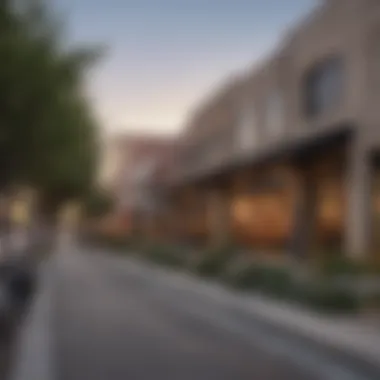Discovering the Best Neighborhoods in San Antonio


Intro
Finding an ideal neighborhood is a critical step in the process of relocating. It extends beyond mere availability of houses; it requires a comprehensive understanding of the local dynamics, lifestyle preferences, and future growth potential. This is especially true in a diverse city like San Antonio, Texas, where each neighborhood presents distinct features that appeal to different types of residents.
In this article, we will delve into various elements that define what makes a neighborhood suitable for different individuals and families. Demographics play a vital role, as they influence community culture and social opportunities. Safety is another key factor that is paramount for many, ensuring that residents feel secure in their environments. We'll also look at amenities and conveniences that enhance daily life, such as schools, parks, shopping, and healthcare facilities. Each of these aspects contributes to the overall lifestyle choices of potential homeowners and renters.
Arming yourself with this information is essential for making informed decisions in the competitive San Antonio housing market. As we analyze neighborhoods, attention will be paid to not only present conditions but also future prospects, enabling readers to envision long-term satisfaction in their community of choice.
Through this thorough exploration, our goal is to help you identify neighborhoods in San Antonio that resonate with your expectations, making your relocation not only a possibility but a positive experience.
Understanding San Antonio's Urban Landscape
Understanding the urban landscape of San Antonio is crucial for identifying ideal neighborhoods. The city combines a rich history, diverse demographics, and economic growth, offering a unique living experience. Factors such as historical significance and modern developments reflect the character and appeal of its neighborhoods.
Historical Background
San Antonio's history shapes its neighborhoods. Founded in 1718, it has evolved from a Spanish outpost to a vibrant city. The presence of historical landmarks, such as the Alamo and Mission San José, adds cultural richness. This historical depth impacts real estate, influencing property values and attracting residents who appreciate both heritage and modern amenities. The preservation of these sites also fosters a unique charm in areas like the King William Historic District.
Current Demographic Trends
Demographics play a vital role in understanding which neighborhoods attract diverse groups. San Antonio has seen significant population growth, driven by an influx of young professionals, families, and retirees. As of 2023, projections indicate a continued trend of becoming a multicultural hub. Neighborhoods such as Alamo Heights and Stone Oak present a mixture of cultures, influencing local businesses and services.
There are different segments of the population to consider. For instance, areas with higher numbers of professionals often have better amenities and schools. Conversely, more affordable neighborhoods attract young families and first-time buyers. Keeping track of these trends helps prospective residents choose a community that fits their lifestyle and needs.
Economic Overview
San Antonio's economy reflects diversity and growth. Major industries include healthcare, military, tourism, and hospitality, contributing to a robust job market. The presence of military bases, like Joint Base San Antonio, provides stable employment opportunities, impacting local housing demands. The economic landscape supports various neighborhoods—from luxury communities to budget-friendly options.
The city has also embraced technology and innovation, fostering startups and expanding potential job markets. This economic variation influences housing prices, rental costs, and overall living conditions. Potential homeowners and renters should consider economic stability as they evaluate neighborhoods, as it determines the area's growth potential and livability.
"San Antonio's neighborhoods mirror its economic diversity, ensuring a range of options for potential residents."
In summary, exploring San Antonio's urban landscape involves understanding its history, demographic shifts, and economic forces. Each factor combines to create neighborhoods that are distinct and appealing to various residents.
Key Factors for Choosing a Neighborhood
Selecting the right neighborhood is a significant step in deciding where to live in San Antonio. Various factors influence this choice, impacting lifestyle, convenience, and long-term satisfaction. Understanding these key elements helps potential residents to align their needs with the unique offerings of each area. The following sections delve into critical considerations: safety, transportation links, and educational facilities. Each is crucial in forming a holistic view of potential neighborhoods and will aid in making an informed decision.
Safety and Crime Rates


Safety is often at the top of the priority list for individuals and families when considering a new neighborhood. Low crime rates are an indicator of a secure environment, reducing the risk of burglaries or violence and creating peace of mind. San Antonio presents varied crime statistics across its neighborhoods. For example, areas like The Alamo Heights typically experience lower crime levels compared to some parts in the West Side.
When evaluating safety, potential residents should check resources such as the San Antonio Police Department's crime map or community forums. Local Facebook groups can also provide insights into recent developments regarding safety in different neighborhoods.
Furthermore, traffic safety is another aspect to consider. Neighborhoods with major roads and high traffic can lead to accidents, impacting overall neighborhood safety.
Accessibility and Transportation
Accessibility and transportation options are of great importance for daily commuting, leisure activities, and overall connectivity. The design of a neighborhood can greatly affect these factors. Some areas in San Antonio, such as Downtown and Stone Oak, offer better access to public transport, highways, and major roads. This allows for easier commutes to work or school and access to the wider city.
- Public Transportation: Reviewing availability of bus routes and connections to light rail services is crucial. San Antonio's VIA Metropolitan Transit is an essential resource for public transport.
- Walkability: Check the walkability score of neighborhoods to determine how pedestrian-friendly they are. This can highly influence quality of life, as residents favor areas where essential services are within walking distance.
- Commute Times: Understanding average commute times to major employment centers can also affect the quality of life.
Educational Opportunities
Education is another major factor influencing the appeal of a neighborhood. Access to quality schools and educational resources can be decisive for families, as well as for individuals looking to invest in properties near reputable institutions.
San Antonio hosts a variety of educational institutions, from public schools governed by the North East Independent School District to private options. Notably, some neighborhoods are home to schools boasting higher ratings based on academic performance.
- Proximity to Schools: Evaluate the distance to local schools, especially if children are involved. A nearby quality school can provide long-term advantages.
- Higher Education: Furthermore, for those pursuing college opportunities, proximity to universities such as The University of Texas at San Antonio can be a critical factor.
In summary, the choice of neighborhood in San Antonio encompasses a multitude of factors. Focusing on safety, accessibility, and education creates a well-rounded perspective. Each element not only affects lifestyle but also contributes to the community's overall appeal.
Exploring Notable Neighborhoods
Exploring neighborhoods captures the essence of what makes a city cohesive and vibrant. In San Antonio, various neighborhoods each exude unique characteristics that cater to different lifestyles and preferences. From cultural richness to modern amenities, understanding these neighborhoods is crucial for potential homeowners and renters. Not only does it aid in making informed decisions, but it also enhances the sense of community one can find in this expansive city. Each neighborhood provides distinct experiences and environments, ultimately impacting one's quality of life.
The Alamo Heights Experience
Alamo Heights stands out as a premier residential area, offering a blend of luxury and accessibility. This neighborhood features picturesque streets lined with mature trees and attractive homes. The local schools are well regarded, making it an attractive option for families. Additionally, the area hosts a variety of boutique shops, art galleries, and dining options. Alamo Heights is near downtown, providing easy access to urban amenities while offering a suburban feel. The environment promotes a strong sense of community, which is desirable for many residents.
The Cultural Appeal of Southtown
Southtown is known for its artistic vibe and cultural richness. This area is home to numerous art studios, theaters, and galleries, creating a vibrant atmosphere. One can frequently find community events, especially during First Friday, where local artists showcase their work. The neighborhood features a mix of historic homes and contemporary developments, appealing to diverse demographics. Southtown is also recognized for its culinary scene, boasting a range of restaurants and cafes that highlight local flavors.
Family-Friendly Living in Stone Oak
Stone Oak is a family-oriented neighborhood in the northern part of San Antonio. It boasts numerous parks, recreational facilities, and excellent schools, making it ideal for families with children. The community emphasizes safety, with a low crime rate and friendly neighborhood watch programs. Stone Oak also features shopping centers, providing convenient access to necessities. The area often hosts family events, which help foster connections among residents, contributing to a welcoming environment for families.
The Vibrancy of Downtown San Antonio
Downtown San Antonio offers a unique urban lifestyle, combining historic charm with modern living. The area is bustling with cultural venues, entertainment options, and dining experiences. Landmarks like the Alamo and the River Walk create a dynamic backdrop for those who enjoy city life. Downtown caters to both young professionals and retirees, making it a diverse living space. Many residents appreciate the walkability of the district, allowing easy access to amenities.


Historic Charm of King William
King William stands as a testament to San Antonio's rich history. The neighborhood is characterized by beautifully restored Victorian mansions and vibrant gardens. King William is home to various cultural festivals, making it a lively hub for residents and visitors alike. The locale maintains a tight-knit community feel, attracting individuals who value tradition and historical significance. Walking through the neighborhood provides a glimpse into the city's past, a feature that many find appealing.
Affordability in West Side
The West Side of San Antonio presents a more affordable living option, attracting a diverse population. This neighborhood may not have the same accolades as others, but it offers important value to residents. Various housing options are available, from single-family homes to apartments, often appealing to first-time buyers. The West Side is rich in community spirit, illustrated by local events and gatherings. Reliable transportation options make it easy to commute to other parts of the city, providing good connectivity without higher living costs.
Lifestyle Considerations in San Antonio
When assessing neighborhoods in San Antonio, it is crucial to consider lifestyle factors that play a significant role in daily living. The essence of a neighborhood is not just about its physical attributes, but also about how it caters to the needs and preferences of its residents. This section analyzes local cuisine, recreational activities, and cultural events, which together create an enriched living experience. Understanding these elements provides valuable insight for potential residents.
Local Cuisine and Dining
San Antonio has a rich culinary tradition, influenced by various cultures, particularly Mexican and Texan. The local dining scene ranges from food trucks offering authentic tacos to fine dining establishments serving gourmet dishes. Neighborhoods like the Pearl District and Southtown are known for their vibrant restaurant scenes. In these areas, residents can explore a variety of cuisines that reflect the city's diverse heritage.
Additionally, the city hosts numerous food festivals throughout the year, celebrating local flavors. The annual San Antonio Cocktail Conference and the Feast festival are just some events that highlight the culinary creativity of the region. Access to unique and high-quality dining options enhances the appeal of a neighborhood, making it attractive for food enthusiasts.
Recreational Activities and Parks
Recreational opportunities are essential for an enjoyable lifestyle. San Antonio is home to numerous parks and outdoor spaces that promote physical activity and community engagement. The San Antonio River Walk offers scenic routes for walking and biking, while Brackenridge Park features lush landscapes suitable for picnics and family outings.
For those who appreciate sports, the city hosts various professional teams, including the San Antonio Spurs. Community sports leagues are also widely available, encouraging participation among residents of all ages. Engaging in these recreational pursuits not only fosters a healthy lifestyle but also builds connections among community members.
Cultural Events and Festivals
San Antonio is a cultural hub, showcasing a variety of art forms and traditions throughout the year. Events such as Fiesta San Antonio and Diwali in the Garden connect residents with the city's rich cultural tapestry. These celebrations feature music, dance, and culinary experiences that reflect the community's diversity.
Moreover, the city's museums and art galleries, such as the San Antonio Museum of Art, play a vital role in promoting local artists and hosting educational programs. Active participation in cultural events can enrich one's living experience and provide a sense of belonging within the community.
"The combination of food, recreation, and culture makes San Antonio a vibrant place to live. Exploring these aspects can lead to a more fulfilling lifestyle."
In summary, considering lifestyle factors when evaluating neighborhoods in San Antonio is fundamental. The local cuisine, recreational activities, and cultural events enhance not only individual preferences but also community connections. Understanding these elements allows potential residents to make informed decisions that suit their lifestyle.
Real Estate Market Overview
The real estate market in San Antonio serves as a critical lens through which potential residents can evaluate ideal neighborhoods. Understanding this market helps individuals, families, and investors make informed choices about where to live or invest. Factors such as market trends, pricing comparisons, and future development projects significantly influence these decisions.
Real estate trends give insight into the overall health of the housing market. Knowledge of current trends informs buyers about whether it is a good time to buy or whether they should wait for better conditions. Furthermore, comparative pricing analysis allows home seekers to understand the value of properties within various neighborhoods. This analysis helps them to pinpoint areas where they can find good deals or verify the merits of their investment.
Lastly, future development projects may present new opportunities for growth or demand in certain areas. These projects can influence long-term property values and living conditions. Therefore, understanding the real estate market in San Antonio is essential for anyone looking to choose the ideal neighborhood.


Current Market Trends
San Antonio's real estate market shows notable trends that reflect both local and national influences. Recently, the city has experienced an increase in demand for housing, partly due to its growing population. As more people move to San Antonio, the demand for residential properties has continued to rise.
Moreover, the increasing interest rates are affecting buying behavior. While higher rates generally discourage borrowing, the strong job market and favorable conditions may still motivate buyers. Investors should also note the rise in purchasing homes, which can influence availability and consequently affect prices.
Homebuyers in San Antonio must keep an eye on these trends to anticipate changes that may impact their purchasing power or decisions.
Comparative Pricing Analysis
When considering a neighborhood in San Antonio, comparative pricing analysis is fundamental. Different neighborhoods offer varying price points based on location, amenities, and demand. The analysis encompasses both selling prices and rental costs.
For instance, neighborhoods such as Alamo Heights and Stone Oak typically come with a higher price tag due to their amenities and quality schools. In contrast, areas like West Side show more affordability but may lack specific amenities that some find desirable.
Homebuyers should assess market listings regularly to avoid overpaying and to understand which neighborhoods provide the best value for their investment. Websites like Reddit and Facebook can offer real-life testimonials and pricing insights from current residents, aiding in a more informed decision.
Future Development Projects
The future development landscape in San Antonio presents a myriad of possibilities. A closer look at planned projects can reveal where the city’s focus lies, particularly in terms of infrastructural improvements and community growth.
Some notable upcoming developments might include new parks, schools, and commercial centers. Such projects not only enhance the living experience but can also lead to increased property values over time. Areas experiencing new developments tend to attract further investments, sparking a cycle of enhancements.
Investors and buyers should actively engage with community forums and local government bulletins to stay updated on these developments. Being informed on future projects helps in choosing neighborhoods with promising growth trajectories and sustainable living conditions.
Understanding the real estate market dynamics in San Antonio is invaluable for making sound investments and finding the right home.
End and Recommendations
The recommendations are influenced by several factors:
- Personal Preferences: Individual needs can differ widely. Some prioritize schools, while others focus on entertainment options.
- Budget Considerations: Housing price ranges are diverse. A careful financial assessment is necessary to find a suitable match.
- Long-Term Planning: Prospective residents should consider future needs. This is especially pertinent for families, where growth and stability may be significant factors.
Summing Up the Ideal Areas
San Antonio is characterized by diverse neighborhoods, each offering unique benefits. Areas like Alamo Heights showcase luxury living, while Stone Oak is favored for family-oriented amenities. Each neighborhood discussed exhibits distinct characteristics that appeal to different demographics. For example:
- Alamo Heights attracts those seeking upscale living with great schools.
- Southtown appeals to artsy individuals drawn to cultural richness.
- West Side provides affordable housing options in a vibrant community.
Choosing an ideal area should consider one's lifestyle and professional commitments. Those who prefer walkable communities may favor Downtown, while commuters might prioritize access to major highways.
Final Thoughts on Relocating
Relocating to a new neighborhood is a significant decision. It is not only about changing an address, but rather about finding a place that aligns with one's values and aspirations. Conducting thorough research can lead to a more fulfilling living experience. This article aims to empower potential movers by highlighting significant aspects of San Antonio's housing landscape.
In summary, it is advisable to visit various neighborhoods in person. Engage with residents and explore amenities. This first-hand experience gives a clearer picture and assists in making informed choices. Additionally, staying updated on local happenings, like cultural events, can enhance the sense of community.
Ultimately, as you embark on this journey of finding your ideal neighborhood in San Antonio, ensure that all considerations are based on a mix of practical needs and personal preferences. Finding the right balance will lead to a happier transition into this vibrant area of Texas.







